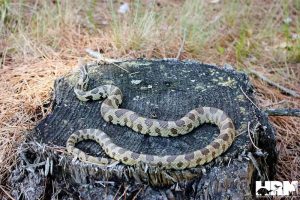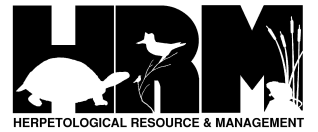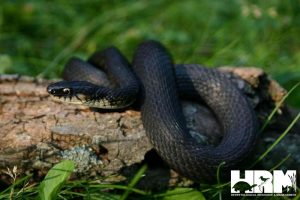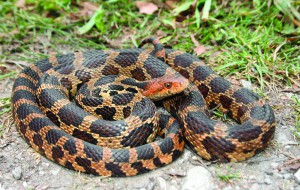Western Fox Snake
Overview:
Scientific Name: Pantherophis vulpina
Size: 35.4 – 61” (adult total length)
Status: Locally common
MDNR Wildlife Action Plan Status: Species of Greatest Conservation Need

Habitat:
Occupies prairie, pastures, and agricultural areas. In northerly areas will inhabit open woodland and forest edges. Occur in pine/oak woodlands and nearby agricultural areas as well as clear-cuts in northern Michigan
Adult Coloration:
Yellowish brown, grayish brown, or tan background with row of brown or black blotches running down back and onto tail. Dorsal blotches alternate with smaller dark blotches on the sides. Head may be yellowish or reddish brown to coppery orange. Dark band between eyes that continues to the edge of the jaw, most often seen in younger individuals. Belly yellow to cream with dark squarish markings.
Adult Characteristics:
Relatively large and stout with a broad head that is widest behind the eyes and a blunt rounded snout. Stout tail narrows to a pointed tip. Scales keeled on upper back but smooth on sides. Anal plate divided.
Scale Count:
23 – 27 scale rows at midbody
Species Confused With:
Eastern Milk Snakes have unkeeled scales and a single anal plate. Juvenile Racers also lack keeled scales and do not have a stripe from the eye to the end of the jaw. Juvenile Black Rat Snakes are similar to juvenile Western Fox Snakes but have greater than 220 ventral scutes (while Fox Snakes have 216 or less). The Eastern Fox Snake is very similar but its range does not overlap with that of the Western Fox Snake, so if seen in the wild these species can be distinguished. Eastern Fox Snakes also have fewer, larger dorsal blotches on body and tail (28-43, 34 on average) while Westerns have an average of 41 (range 32-52) smaller blotches.
References:
- Amphibians and Reptiles of the Great Lakes Region by Jim Harding
- Harding, J.H. and J.A. Holman. 2006. Michigan Snakes. MSU Extension Ext. Bulletin E-2000,74 pp. [revised].
- Ruthven, A. G., H. B. T. Gaige, et al. 1912. The herpetology of Michigan, by Alexander B. Ruthven. Crystal Thompson and Helen Thompson; Memoranda towards a bibliography of the archaeology of Michigan, by Harlan I. Smith; prepared under the direction of Alexander G. Ruthven. Lansing, Mich., Wynkoop Hallenbeck Crawford, State Printers.
- Holman, J. A. 2012. The Amphibians and Reptiles of Michigan: A Quaternary and Recent Faunal Adventure. Detroit, Mich., Wayne State University Press.
- Conant, R., and Collins, J. T. 1998. Reptiles and Amphibians: Eastern, Central North America. Houghton Mifflin Harcourt Press.


